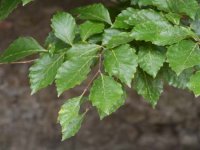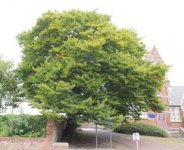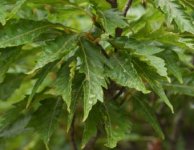-
Welcome to BirdForum, the internet's largest birding community with thousands of members from all over the world. The forums are dedicated to wild birds, birding, binoculars and equipment and all that goes with it.
Please register for an account to take part in the discussions in the forum, post your pictures in the gallery and more.
You are using an out of date browser. It may not display this or other websites correctly.
You should upgrade or use an alternative browser.
You should upgrade or use an alternative browser.
Tree identification - help needed (1 Viewer)
- Thread starter PaulD
- Start date
More options
Who Replied?Jane Turner
Well-known member
Well the left hand leaves and the overall tree look like beech, but the other leaves are weird.
foresttwitcher
Virtually unknown member

The leaves in the first photo appear to be beech but are a bit more toothed / serrated than wood be expected from Fagus sylvestris.
The overall tree does have the form of a beech.
The leaves in the third photo look more like the Cut-leaved or Fern-leaved (Asplenifolia) form but don't seem to be indented or cut enough. But the leaves of this form can appear intermediate as it is a chimaera.
How were the different foliage types distributed within the crown of the tree? If just a clump were atypical it may be as a result of a gall of some sort.
I'm not sure American Beech can be excluded from the photos as these have more serrated leaves than the European species, but not as extreme as the foliage in the third picture!
The overall tree does have the form of a beech.
The leaves in the third photo look more like the Cut-leaved or Fern-leaved (Asplenifolia) form but don't seem to be indented or cut enough. But the leaves of this form can appear intermediate as it is a chimaera.
How were the different foliage types distributed within the crown of the tree? If just a clump were atypical it may be as a result of a gall of some sort.
I'm not sure American Beech can be excluded from the photos as these have more serrated leaves than the European species, but not as extreme as the foliage in the third picture!
chris butterworth
aka The Person Named Above
The leaves in the third photo do appear to be galled. The way they seem to be rather densely distributed could mean it's a form of crown gall that tends to develop when bacteria such as Agrobacterium enters a wound. The other alternative is that it's a branch that has naturally developed as a 'sport', as the shape of the leaves is reminiscent of 'Grandidenta' Beech.
Chris
Chris
Welsh Peregrine
Well-known member
Are we all barking up the wrong tree? Surely the toothed leaves makes it a Hornbeam, var Incisa has the deeply cut leaves, but reverts readily to the typical form.
chris butterworth
aka The Person Named Above
Are we all barking up the wrong tree? .
"Boom boom" :t:
Hornbeams, and Hop-Hornbeams,have 'double toothed' leaves, deeper set veins ( and more of them ) and a more elongated leaf, than those shown in the first photo. Roble Beech Nothofagus obliqua has similarly shaped leaves, but they tend to have quite noticeable lobes at the base and, unlike the photo of the whole tree, are tall, rather columnar in shape and with a much more open crown.
Chris
foresttwitcher
Virtually unknown member

Are we all barking up the wrong tree? Surely the toothed leaves makes it a Hornbeam, var Incisa has the deeply cut leaves, but reverts readily to the typical form.
As well as Chris's comments, I believe that hornbeam leaves would be more matt in appearance on the upper surface rather than the more typical glossy green beech.
Last edited:
This is certainly a Common Beech which at some stage has maybe even been grafted and which has some parts of it reverting, not my thoughts but those of an ex Curator of Botanic Gnd
Thanks for your comments. As a beginner with trees I'd certainly be interested in a bit more detail on that, especially with regard to what might be involved in the grafting.
Many Thanks
Sporting on trees etc. Found this article.
Sports do not arise that often, but are not difficult to find if you know what you are looking for. A sport usually occurs because of a genetic mutation or fault in a new shoot. As the shoot grows into a branch, all the leaves or fruit on that one branch will be noticeably different from the rest of the tree. The difference could be a more interesting colouration of the fruit, or the fruit on the sport branch may appear to be less affected by disease. If the sport characteristics are desireable the grower can propagate new trees from the sport branch, and these new trees will then be identical to the sport branch rather than the original tree. It is sometimes said that sports are genetically identical to the original variety, but this is debateable since the sport could be the result of a mutation or it could be the result of a different expression of the same genetic structure. Either way, a sport is far closer genetically to its original variety than a normal variety bred from parent varieties would be. It is probably best thought of as a failed clone rather than an offspring in the conventional sense.
Sports do not arise that often, but are not difficult to find if you know what you are looking for. A sport usually occurs because of a genetic mutation or fault in a new shoot. As the shoot grows into a branch, all the leaves or fruit on that one branch will be noticeably different from the rest of the tree. The difference could be a more interesting colouration of the fruit, or the fruit on the sport branch may appear to be less affected by disease. If the sport characteristics are desireable the grower can propagate new trees from the sport branch, and these new trees will then be identical to the sport branch rather than the original tree. It is sometimes said that sports are genetically identical to the original variety, but this is debateable since the sport could be the result of a mutation or it could be the result of a different expression of the same genetic structure. Either way, a sport is far closer genetically to its original variety than a normal variety bred from parent varieties would be. It is probably best thought of as a failed clone rather than an offspring in the conventional sense.
If this is a sport I would expect it to only be showing as one or two branches. It would be interesting if the OP could tell us which of the two foliage types described in the photos is most dominant over the whole tree. Another identification aid is that if the tree is a Beech (Fagus sylvatica) then the bark of the trunk should be greyish, reminiscent of an elephant’s leg.
Dave
Dave
Last edited:
If this is a sport I would expect it to only be showing as one or two branches. It would be interesting if the OP could tell us which of the two foliage types described in the photos is most dominant over the whole tree. Another identification aid is that if the tree is a Beech (Fagus sylvatica) then the bark of the trunk should be greyish, reminiscent of an elephant’s leg.
Dave
Apologies for the slow reply. The leaves shown in the first photo are the dominant ones, being found across about three-quarters of the tree. The other leaves do however occur on several branches at both the front and back of the tree. The bark is a greyish colour.
Users who are viewing this thread
Total: 2 (members: 0, guests: 2)







